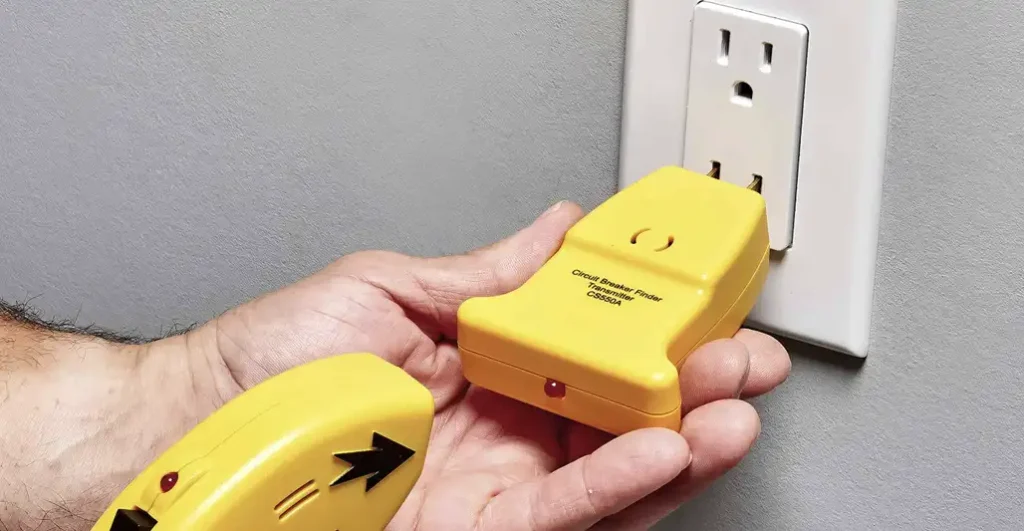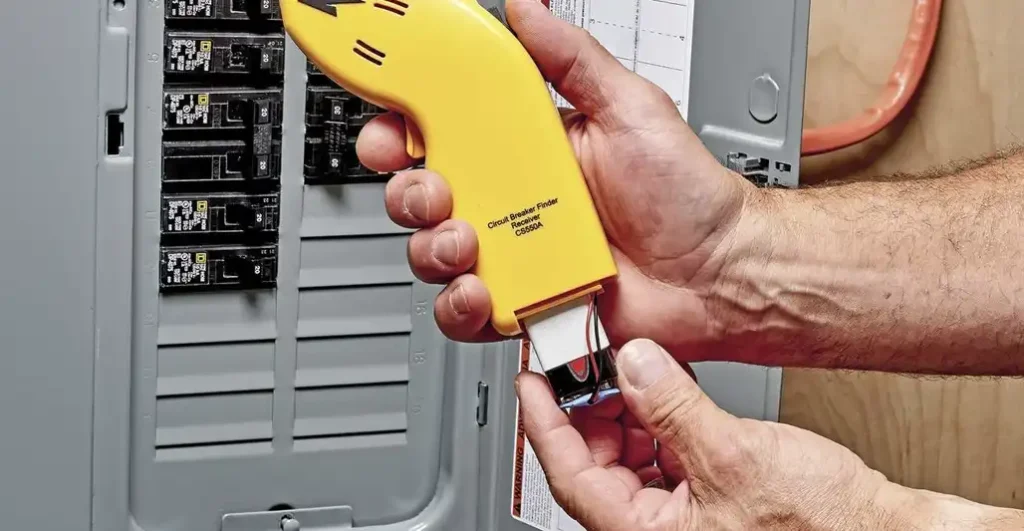In today’s modern world, where electricity powers nearly every aspect of our lives, knowing how to locate a circuit breaker is a crucial skill. Whether you’re experiencing a power outage or need to shut off electricity to a specific area for maintenance or repairs, understanding how to find and operate your circuit breaker is essential.
This guide will walk you through the process step by step, ensuring you have the knowledge you need to handle any electrical situation safely and effectively.
What is Circuit Breaker Finder

A Circuit Breaker Finder is a tool designed to help you quickly and accurately locate the specific circuit breaker controlling a particular electrical outlet or fixture. Here’s how it works and what it typically involves:
Components
- Transmitter: This part plugs into the electrical outlet or connects to the fixture you’re trying to trace.
- Receiver: This handheld device is used to scan the circuit breakers in the electrical panel to identify the correct one.
How It Works
- Connect the Transmitter: Plug the transmitter into the outlet or connect it to the fixture you want to trace. The transmitter sends a signal through the circuit.
- Scan with the Receiver: Take the receiver to the electrical panel and scan the breakers. The receiver will detect the signal from the transmitter.
- Identification: When the receiver finds the breaker carrying the transmitter’s signal, it will alert you, typically through a visual indicator, a beep, or both. This identifies the specific breaker controlling the outlet or fixture.
Benefits
- Efficiency: Quickly find the correct circuit breaker without the trial-and-error method of flipping breakers.
- Safety: Minimize the risk of accidentally turning off important circuits or appliances.
- Convenience: Ideal for electricians and DIY enthusiasts to save time and effort in electrical projects.
How to Use a Circuit Breaker Finder
- Preparation: Ensure that the circuit you are testing is live. Turn on the light or plug in a device to confirm.
- Connect the Transmitter: Plug the transmitter unit into the outlet or attach it to the fixture.
- Scan the Breaker Panel: Use the receiver to scan each breaker in the panel. Move it slowly over each breaker.
- Identification: Listen for the beep or watch for the visual signal on the receiver that indicates the correct breaker.
Tips for Effective Use
- Read Instructions: Follow the manufacturer’s instructions for the specific model you’re using.
- Multiple Circuits: If there are multiple circuits, you may need to check all to ensure you’ve found the correct breaker.
- Practice: Familiarize yourself with the tool on a known circuit to understand its signals and sensitivity.
Where is a Circuit Breaker Located
Let’s delve deeper into where you can find a circuit breaker.
Electrical Panel or Breaker Box:
The primary location of a circuit breaker is within the electrical panel or breaker box. This panel serves as the central hub for distributing electricity throughout a building or home. It contains multiple circuit breakers, each responsible for controlling the flow of electricity to specific areas or appliances.
Placement within the Building:
The electrical panel is typically installed in a strategically chosen location within the building. This location is often chosen for accessibility and safety. Common placements include utility rooms, basements, garages, or on an exterior wall of the house. The panel should be easily reachable in case of emergencies or when performing maintenance.
Accessibility:
Building codes and safety regulations dictate that the electrical panel must be easily accessible. It should not be obstructed by furniture, stored items, or other obstacles. This ensures that homeowners and electricians can quickly access the circuit breakers to shut off power in case of electrical faults or emergencies.
Labeling:
Inside the electrical panel, each circuit breaker is typically labeled to indicate which area or appliance it controls. This labeling helps homeowners and electricians identify the circuits and troubleshoot electrical issues more efficiently.
Safety Considerations:
It’s essential to handle circuit breakers with caution. When working with the electrical panel, always shut off the main power supply to avoid the risk of electric shock. If you’re not familiar with electrical systems, it’s best to leave any repairs or modifications to a qualified electrician.
How to Locate a Circuit Breaker

Locating a circuit breaker involves identifying the electrical panel or breaker box within your home or building. Here’s a step-by-step guide on how to find circuit breaker:
Know the Common Locations:
Utility Room: Often, electrical panels are installed in utility rooms where other essential systems like the furnace or water heater might be located.
Basement: If your home has a basement, this is a likely place to find the electrical panel, typically mounted on a wall.
Garage: In many homes, particularly those without basements, the electrical panel can be found in the garage.
Exterior Wall: In some houses, especially older ones, the electrical panel may be installed on an exterior wall of the building.
Look for a Metal Box:
The electrical panel is usually a gray metal box that might be recessed into the wall or surface-mounted. It often has a door that opens to reveal the circuit breakers inside.
Check for Labels or Signs:
There might be labels or signs indicating the location of the electrical panel, especially in larger buildings. Look for labels that say “Electrical Panel,” “Breaker Box,” or “Service Panel.”
Access the Panel:
Once you’ve located the panel, open the door to access the circuit breakers. Be cautious and ensure your hands are dry to avoid any risk of electric shock.
Identify the Main Breaker:
Inside the panel, you’ll typically see one large switch at the top or bottom, known as the main breaker, which controls power to the entire building. Below or above this are smaller switches, each representing individual circuit breakers.
Labeling and Documentation:
Many panels have a diagram or list on the inside of the door or nearby that details what each breaker controls. This can help you quickly identify the breaker you need to locate.
Safety Precautions:
If you need to turn off a breaker, first ensure that the devices or appliances on that circuit are turned off. Use one hand to flip the breaker switch to avoid creating a circuit through your body.
Consult Building Plans:
For commercial buildings or more complex home setups, building plans or electrical diagrams can help you locate the electrical panel. These documents might be available from the building manager or kept in a designated area like a maintenance room.
By following these steps, you should be able to locate the circuit breaker in your home or building. If you’re unable to find it or if you’re uncomfortable dealing with electrical systems, it’s advisable to seek assistance from a professional electrician.
Conclusion
In conclusion, finding a circuit breaker involves locating the electrical panel or breaker box within your home or building. This panel is typically found in accessible areas such as a utility room, basement, garage, or sometimes on an exterior wall. Look for a gray metal box, often labeled and containing multiple switches.
To locate the circuit breaker:
- Search Common Locations: Check utility rooms, basements, garages, or exterior walls.
- Identify the Panel: Look for a gray metal box, possibly labeled, with a door that opens to reveal the circuit breakers inside.
- Access and Labeling: Open the panel door to access the breakers, and refer to any labels or diagrams to identify specific circuits.
- Safety First: Ensure safety by handling the panel with dry hands and turning off devices before switching breakers.
If you encounter difficulties or are unsure about handling electrical systems, consult a professional electrician for assistance.